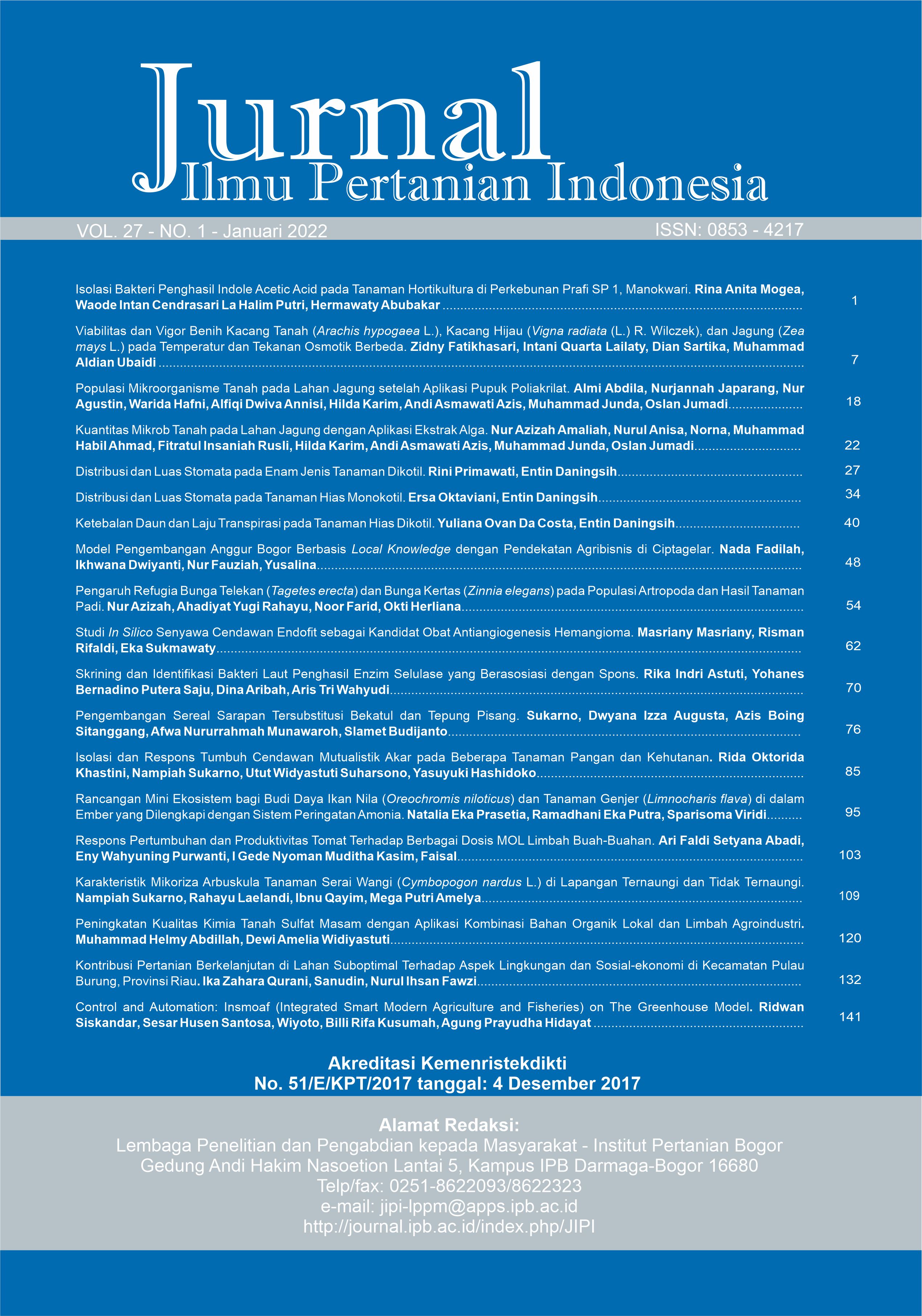Skrining dan Identifikasi Bakteri Laut Penghasil Enzim Selulase yang Berasosiasi dengan Spons
Abstract
Marine bacteria associated with sponges can be used as a source of new enzymes, especially cellulase which are potentially used for various industries. The aim of this study was to screen and identify the cellulolytic bacteria associated with sponges. A total of 38 isolates have been successfully isolated from sponges Aaptos sp., Euryspongia sp., and Haliclona sp. by a spread plate method. Amongst 38 isolates, 14 (37%) showed cellulolytic activities in carboxy methyl cellulose (CMC) medium with a cellulolytic index ranging from 0.31 to 1.63. The three highest cellulolytic index was exhibited by bacterial isolates coded Y.5.10, Y.5.11, and Y.40.6. Isolates Y.5.10, Y.5.11, and Y.40.6 showed cellulolytic activity of 0.0053 U/mL; 0.0083 U/mL; and 0.0124 U/mL, respectively, as were tested by spectrophotometry. The highest specific enzymatic activity was showed by isolate Y.40.6 with a value of 0.3391 U/mg. Based on 16S rRNA gene, isolate Y.5.10, Y.5.11, and Y.40.6 were highly similar to (similarity ≥ 99%) Bacillus sp., B. subtilis, and B. cereus, respectively.
Keywords: cellulase, isolation, sponge-associated bacteria, 16S rRNA
Downloads
References
Ali N, Ting Z, Khan YH, Athar MA, Long M. 2014. Enzymatic hydrolysis of cellulosic biomass for the production of biofuels, a review. International Journal of Engineering and Technical Research. 2(12): 89–96.
Azadian F, Badoei-dalfard A, Namaki-Shoushtari A, Hassanshahian M. 2016. Purification and biochemical properties of a thermostable, haloalkaline cellulase from Bacillus licheniformis AMF-07 and its application for hydrolysis of different cellulosic substrates to bioethanol production. Miriam Budiardjo Resource Center. 5(3): 143–155.
Bradford MM. 1976. A rapid and sensitive method for the quantitation of microgram quantities of protein utilizing the principle of protein-dye binding. Anal Biochem. 72: 248–254. https://doi.org/10.1016/ 0003-2697(76)90527-3
dos Santos YQ, de Veras BO, de França AFJ, Gorlach-Lira K, Velasques J, Migliolo L, dos Santos EA. 2018. A new salt-tolerant thermostable cellulase from a marine Bacillus sp. strain. Journal of Microbiology Biotechnology. 28(7): 1078–1085. https://doi.org/10.4014/jmb.1802.02037
Fatokun EN, Nwodo UU, Okoh AI. 2016. Classical optimization of cellulase and xylanase production by a marine Streptomyces species. Applied Sciences 6(10): 286–299. https://doi.org/10.3390/ app6100286
Gaur R, Tiwari S. 2015. Isolation, production, purification and characterization of an organic-solvent-thermostable alkalophilic cellulase from Bacillus vallismortis RG-07. BMC Biotechnology. 5:19. https://doi.org/10.1186/s12896-015-0129-9
Gohel HR, Contractor CN, Ghosh SK, Braganza VJ. 2014. A comparative study of various staining techniques for determination of extra cellular cellulase activity on carboxy methyl cellulose (CMC) agar plates. International Journal of Current Microbiology and Applied Sciences. 3(5): 261–266.
Kuhad RC, Gupta R, Singh A. 2011. Microbial cellulases and their industrial applications. Enzyme Research 2011: ID280696. https://doi.org/ 10.4061/2011/280696
Lavrov AI, Kosevich IA. 2014. Sponge cell reaggregation: Mechanisms and dynamics of the process. Russian Journal of Developmental Biology. 45(4): 205–223. https://doi.org/10.1134/ S1062360414040067
Maharsiwi W, Astuti RI, Meryandini A, Wahyudi AT. 2020. Screening and characterization of sponge-associated bacteria from Seribu Island, Indonesia producing cellulase and laccase enzymes. Biodiversitas. 21(3): 975–981. https://doi.org/ 10.13057/biodiv/d210317
Marchesi JR, Sato T, Weightman AJ, Martin TA, Fry JC, Hiom SJ, Wade WG. 1998. Design and evaluation of useful bacterium-specific PCR primers that amplify genes coding for bacterial 16S rRNA. Applied and Environmental Microbiology Journal. 64(2): 795–799. https://doi.org/10.1128/AEM.64. 2.795-799.1998
Miller GL. 1959. Use of dinitrosalicylic acid reagent for determination of reducing sugar. Analytical Chemistry. 31(3): 426–428. https://doi.org/10.1021/ ac60147a030
Prastya ME, Astuti RI, Batubara I, Wahyudi AT. 2019. Antioxidant, antiglycation and in vivo antiaging effects of metabolite extracts from marine sponge-associated bacteria. Indian Journal of Pharmaceutical Sciences. 81(2): 344–353. https:// doi.org/10.36468/pharmaceutical-sciences.516
Rini AF, Yuhana M, Wahyudi AT. 2017. Potensi bakteri penghasil senyawa bioaktif yang berasosiasi dengan spons sebagai biokontrol penyakit vibriosis pada udang. Jurnal Akua Indonesia. 16(1): 41–50. https://doi.org/10.19027/jai.16.1.41-50
Safari WF, Chasanah E, Wahyudi AT. 2016. Antibacterial and anticancer activities of marine bacterial extracts and detection of genes for bioactive compounds synthesis. International Journal of Pharmacy and Pharmaceutical Sciences 8(2): 55–59. https://innovareacademics.in/ journals/index.php/ijpps/article/view/9778.
Santos-Gandelman JF, Giambiagi-deMarval M, Oelemann WMR, Laport MS. 2014. Biotechnological potential of sponge-associated bacteria. Current Pharmaceutical Biotechnology. 15: 143–155. https://doi.org/10.2174/13892010 15666140711115033
Shobharani P , Yogesh D, Halami PM, Sachindra NM. 2013. Potential of cellulase from Bacillus megaterium for hydrolysis of Sargassum. Journal of Aquatic Food Product Technology. 22: 520–535. https://doi.org/10.1080/10498850.2012.670836
Tabssum F, Irfan M, Shakir HA, Qazi JI. 2018. RSM based optimization of nutritional conditions for cellulase mediated saccharification by Bacillus cereus. Journal of Biological Engineering. 12(1): 7–16. https://doi.org/10.1186/s13036-018-0097-4
Thomas TRA, Kavlekar DP, LokaBharathi PA. 2010. Marine drugs from spongemicrobe association-A review. Marine Drugs. 8: 1417–1468. https://doi.org/10.3390/md8041417
Trivedi N, Reddy CRK, Lali AM. 2016. Chapter two - marine microbes as a potential source of cellulolytic enzymes. Advances in Food and Nutrition Research. 79: 27–41. https://doi.org/10.1016/ bs.afnr.2016.07.002
Vartoukian SR, Palmer RM, Wade WG. 2010. Strategies for culture of ‘unculturable’ bacteria. FEMS Microbiology Letters. 309(1): 1–7. https://doi.org/10.1111/j.1574-6968.2010.02000.x
Wahyudi AT, Qatrunnada, Mubarik NR. 2010. Screening and characterization of protease inhibitors from marine bacteria associated with sponge Jaspis sp. HAYATI Journal of Biosciences. 17 (4): 173–178. https://doi.org/10.4308/ hjb.17.4.173
Webster NS, Taylor MW. 2012. Marine sponges and their microbial symbionts: Love and other relationships. Environmental Microbiology. 14(2): 335–346. https://doi.org/10.1111/j.1462-2920.2011.02460.x
Webster NS, Thomas T. 2016. The sponge hologenome. ASM. 7(2): 1–14. https://doi.org/ 10.1128/mBio.00135-16
This journal is published under the terms of the Creative Commons Attribution-NonCommercial 4.0 International License. Authors who publish with this journal agree to the following terms: Authors retain copyright and grant the journal right of first publication with the work simultaneously licensed under a Creative Commons Attribution-NonCommercial 4.0 International License. Attribution — You must give appropriate credit, provide a link to the license, and indicate if changes were made. You may do so in any reasonable manner, but not in any way that suggests the licensor endorses you or your use. NonCommercial — You may not use the material for commercial purposes.






















